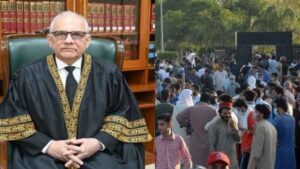Supreme Court judge, the nation’s highest court, has brought up the significant issue of whether the offenses committed on May 9 are more serious than psychological militant occurrences. The May 9 episodes, which included enormous scope distress and savagery, have been a subject of extraordinary discussion in the legitimate and political fields. While many view these offenses as demonstrations of hostility against the state, others contend that they don’t arrive at the seriousness of psychological oppression, which usually includes planned demonstrations of brutality with the goal of dread and disturbing the social request.
The adjudicator’s remarks challenge the lawful understanding of such occasions and focus on the intricacies involved in ordering offenses. Psychological oppression, by definition, is intentional and coordinated work to ingrain dread for philosophical or political purposes, frequently with extensive outcomes. Interestingly, the May 9 offenses, however fierce and troublesome, may not fit conveniently into this structure, contingent upon the unique situation and inspirations driving the activities.

This question has ignited a more extensive discussion about state savagery, political turmoil, and the general capacity of laws to recognize different types of hostility reasonably. The court’s investigation into the seriousness of these offenses could have critical ramifications for how such episodes are arraigned and the punishments forced, impacting future legitimate and political reactions to comparable occasions.
The May 9 Incident: A Catalyst for National Debate
The May 9 viciousness, while phenomenal in its extension and power, was seen by a lot of people as a political articulation that turned out badly. Allies of the captured pioneer participated in the fights, which before long transformed into savage showdowns with the police and military. The assaults were aimed at images of state authority, and there were reports of hordes burning down government structures, obliterating vehicles, and participating in road fights with policing.
Whether or not this episode could be compared with demonstrations of psychological oppression has been raised because of the contribution of vast quantities of regular folks and political figures in the brutality, as opposed to conventional fear-monger cells. The line between political distress and psychological warfare, particularly in a politically charged climate, is slim, and the seriousness of the violations is being addressed with regard to different occurrences.
Justice Gupta’s Remark: Challenging the Classification of Offences
Equity Gupta’s comments, made during a catching wind of the legitimate outcomes of the May 9 occasions, focused on whether the offenses committed during the mobs ought to be treated with the very lawful system that is usually held for psychological oppression cases. He brought up that the fear-based oppressor name conveys enormous weight, and there are many times an assumption of brutal discipline for such offenses. His anxiety was that applying such a mark could prompt superfluous lawful ramifications for people who were, in his view, acting in political dissent, not participating in psychological warfare essentially.
His assertion proceeded to contrast the May 9 episodes and demonstrations of psychological warfare in the nation’s set of experiences, taking note that while the May 9 occasions caused significant harm and misfortune, there were no apparent signs that the fights had similar long haul, philosophically determined objectives of a fear monger assault. Psychological oppressor acts are,e by and large, done with the plan to weaken the state, spread dread, and advance a particular reason, frequently with coordination and assets from coordinated networks. Conversely, the May 9 occasions were viewed as more unconstrained, powered by political shock, instead of a coordinated, calculated plot to undermine the state.
The Definition of Terrorism: A Legal and Political Dilemma
The remarks of the Adjudicator for the nation’s highest court have brought to the forefront the perplexing idea of characterizing and arraigning psychological oppression. Psychological warfare, by its legitimate definition, for the most part, includes purposeful demonstrations of viciousness, terrorizing, and compulsion determined to impact government strategy, impart dread in general society, or test the actual texture of state authority. The commonplace psychological militant demonstration is efficient, frequently with clear goals, and often completed by radical gatherings or organizations.

Nonetheless, the May 9 episode didn’t fit conveniently into this classification. Although the obliteration of state property and the assaults on security forces were rough, many contended that these were demonstrations of political dissent and not really characteristic of a more extensive, composed, psychological militant mission. This differentiation has significant lawful ramifications regarding charges, possible punishments, and condemnation.
A Comparative Perspective: Previous Terrorism Cases
Equity Gupta’s test originates from looking at the seriousness of the May 9 offenses to other past fear-monger occurrences, for example, bombings or assaults on open foundations that were arranged and executed with the reasonable goal of threatening the populace. The 2008 Mumbai assaults, for instance, involved profoundly coordinated, cross-line psychological warfare with the goal of incurring the most significant nonmilitary personnel losses and making a broad frenzy. Also, assaults from radical gatherings in the north and east of the nation had been driven by philosophical and strict inspirations, planning to weaken the public authority.
Interestingly, the May 9 fights were considered more of a political articulation but one that spiraled crazy. The members were not really persuaded by a craving to ingrain dread or cut down the public authority but instead to fight a capture they saw as politically motivated. In this manner, the inquiry remains whether the force of the viciousness is sufficient to classify it as psychological warfare or, on the other hand, whether it ought to be seen as a grave but unmistakable type of everyday turmoil.
The Political Nature of the May 9 Protests
The political setting surrounding the May 9 episodes further complicated the lawful treatment of the events. The protestors were not just engaged in irregular brutality. Instead, they were driven by a particular political complaint—the public authority illegitimately confined the capture of their chief, who they accepted added a component of political activism to the brutality, obscuring the line between illegal intimidation and dissent.
Nonconformists, particularly those associated with political developments, frequently face criminal accusations related to their activities. However, the goal behind their activities is crucial in deciding whether they ought to be classified as psychological militants or, on the other hand, whether their offenses ought to be called violations of political articulation or everyday rebellion. In this situation, the savage idea of the fights muddled matters, as they included head-on conflict with policing state foundations yet without clear connections to a coordinated, fear-mongering bunch.
The Legal Framework for Terrorism and Civil Unrest
How these episodes ought to be treated under the law remains a topic of much conversation in legitimate circles. Demonstrations of psychological oppression are typically arraigned under unique psychological oppression regulations that convey extreme punishments, frequently including life detainment or even capital punishment for certain nations. Political fights—regardless of how brutal—are typically arraigned under various arrangements, frequently with less severe results.

Equity Gupta’s remarks appear to challenge the utilization of such brutal psychological oppression regulations with regard to the May 9 fights, particularly given the absence of evidence highlighting a coordinated, politically propelled fear-monger network behind the activities. The legitimate ramifications of regarding the occasion as psychological oppression versus political distress have boundless ramifications for how comparative occurrences will be treated from now on.
Public Opinion and Political Ramifications
The decision could have significant political repercussions, as the treatment of the May 9 guilty parties is likely to influence general assessment. A decision ordering these to be treated as illegal intimidation could prompt allegations of political inclination, with many accepting that political protestors are generally unjustifiably rebuffed. Then again, assuming the offenses are delegated to common distress or political dispute, it may be viewed as subverting the earnestness of the brutality that happened, possibly prompting calls for additional extreme activities against those included.
The Role of the Judiciary in Upholding Justice
The High Court’s association with this situation highlights the significant role the legal executive plays in adjusting regulation and equity. Judges should weigh the seriousness of the offenses and the more extensive political and social ramifications of their decisions. Equity Gupta’s comments recommend that while the law should remain firm, it ought to likewise stay adaptable and sensitive to the subtleties of each case, especially when political inspirations are involved.
Frequently Asked Questions
What is the May 9 occurrence?
The May 9 episode alludes to brutal turmoil in the nation, including fights and conflicts that heightened to critical common issues.
What did the Justice for the highest court address?
The appointed authority addressed whether the offenses committed on May 9 were more serious than demonstrations of psychological warfare.
Why contrast these offenses with illegal intimidation?
Psychological warfare typically includes planned brutality pointed toward making dread and disturbing society, and the adjudicator is testing whether May 9 offenses fit this seriousness.
What is illegal intimidation characterized as?
Illegal intimidation involves using savagery to create fear, frequently with political or philosophical motives, and planning to weaken social orders.
What are the conceivable lawful ramifications of this examination?
The correlation could influence how offenses are arraigned and the seriousness of punishments forced.
Was the May 9 occurrence arranged?
The inquiry remains discussed. Some contend it was an unconstrained flare-up of savagery, while others recommend fundamental political inspirations.
What are the outcomes of classifying these offenses as psychological warfare?
On the off chance that delegated psychological warfare, the lawful results could incorporate crueler punishments, for example, lengthy jail terms or even the death penalty.
How do courts separate between political agitation and illegal intimidation?
Courts consider the plan, scale, and effect of brutality and closely examine the political inspirations behind it.
Could this request change future lawful reactions to turmoil?
Indeed, the result of this case could shape future lawful points of reference for dealing with political savagery.
What’s the more extensive meaning of this inquiry?
It considers state authority, individual privileges, and the force of political development and could have long-term cultural ramifications.
Conclusion
The Justice for the highest court’s scrutinizing of whether the May 9 offenses are more serious than psychological oppressor acts mirrors a more profound legitimate and philosophical assessment of political viciousness. This request isn’t just about surveying the occasions of that day but also understanding how society ought to legitimately address demonstrations of hostility that obscure the lines between fight, typical defiance, and psychological oppression. The results of such an inquiry could have significant ramifications on the legitimate scene, impacting how specialists handle comparable occurrences later on. Besides, this issue dives into the harmony between keeping up with public safety and protecting everyday freedoms, bringing up fundamental issues about the degree of state power and individual opportunities in the midst of turmoil.

